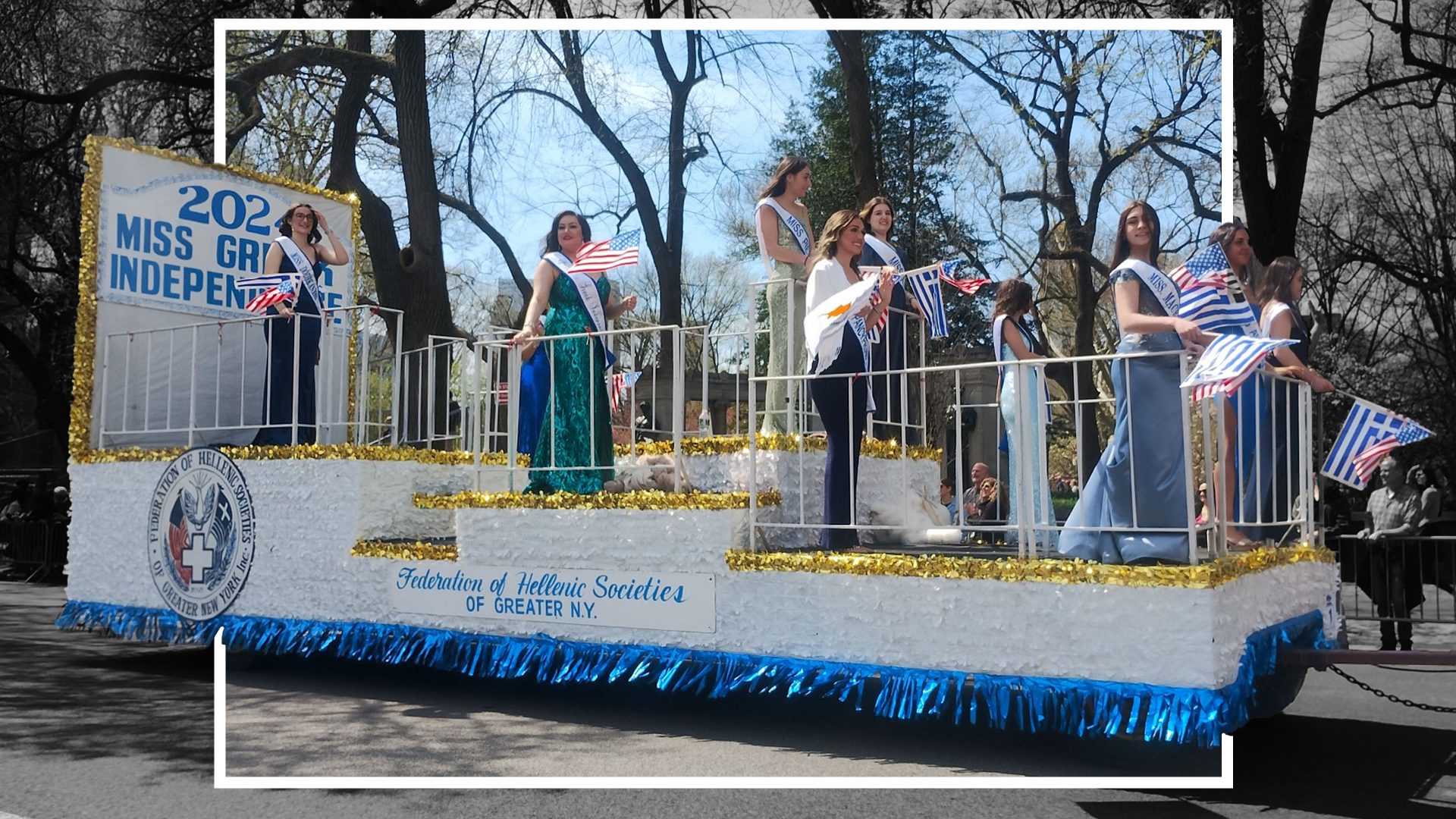How many Greek orthodox churches are there in New York? According to Gregory, 62 and originally from Crete, there are ten of them in Manhattan, and a number of others in Queens, Brooklyn and the other boroughs.
If you stand on 5th Ave and watch the city’s Greek Independence Day Parade as it snakes up the side of Central Park, however, you will soon begin to wonder if Gregory was perhaps underselling it. You may, by the second or third hour, even think to yourself that there must be about as many Greek orthodox churches in New York as there are grains of sand on any given beach.
It isn’t entirely surprising. There are, after all, around 300,000 Greeks in the state of New York, making it the second largest community of Greeks outside their home country after Melbourne.
Though some began arriving in the early and mid 19th century, the first real wave of migration came between 1880 and 1920. Greece’s economy was struggling and the agriculture industry in the south was declining, and so farmers and craftsmen crossed the Atlantic to try their luck in America.
The continent’s Greek Orthodox Archdiocese was incorporated in 1921 and formally recognised by the state of New York a year later, meaning that the church soon became the focal point of the community. In 1938, the first Greek Independence Day Parade was held, and soon became a beloved tradition.
Another wave of Greeks arrived in the 60’s and 70’s, following the relaxing of immigration rules in the US. In 1970, New York City was home to around 350,000 Greeks. Many of them started out in Manhattan then eventually found a home in Astoria, in Queens. The neighbourhood, with its low buildings and quiet atmosphere, was said to feel more European than the hectic island next door.
As time went on, many Greek families moved away from the city altogether, embracing a more suburban life.
It’s a journey 59-year-old Paul and his family went on. “I was born in Athens. I came here when I was five. First we moved to Manhattan, Hell’s Kitchen, in the middle of a huge Irish immigrant community,” he said.
“There was a big constituency of Greeks who worked in the food industry. My parents were bakers and they owned bakery stores. The natural transformation is that the kids now no longer do a lot of hard jobs, they’ve got educated, their parents passed away, so now they’re doctors, lawyers, engineers, politicians, businessmen. Things have transformed, but in the right way.”
Still, he and many others come back to the Upper East Side once a year to watch and cheer on the parade, as they have done for decades.
Many of the churches have floats and so do a lot of the Greek language schools. Perhaps most glamorous is the float carrying the winner and runners-up of the annual Miss Greek Independence pageant.
Back in March, twelve young women had competed for the title, which focused both on beauty and ties to the Greek American community, as well as Greek heritage in general. Katerina Karandrika, who won the tiara and the sash, waved at the whooping crowd, flanked by Miss Athens, Miss Macedonia and Miss Olympia.
The girls weren’t the only ones nodding at the country’s history. Over the three or so hours, dozens of men and women, pensioners and children, walked down while wearing traditional costumes. There were several marching bands – what parade is complete without them? – and seemingly every profession was represented.
Chuck Shumer, the Democratic politician and Senate majority leader was given a hero’s welcome, and so was NYC mayor Eric Adams. Even more exciting for casual attendees was probably George Karlaftis, a two-time winner of the NFL’s Super Bowl and player for the Kansas City Chiefs, who acted as the parade’s grand marshal.
Oh, and there were flags – so many flags. Greek ones, American ones and, somewhat more controversially, countless Cypriot ones. This was probably because of the march’s dual purpose this year: it was about celebrating Greece’s independence from the Ottoman empire, sure, but also about the 50th anniversary of Turkey’s invasion of Cyprus.
The parade may usually be a happy occasion but, this time round, many of the messages were political. They were chants, in Greek of “Turks out of Cyprus!”, and placards showing a third of the island covered in blood – marking the Turkish area.
Among the many banners on show were “Never Forget”, “the dream of a free Cyprus will never die”, and “Turkish troops out of Cyprus”. Those sentiments were echoed by the people watching from the sidelines.
“It’s Greek independence day, but we’re also here because it’s commemorating 50 years of occupation of Turkey in Cyprus. We’re all Greek Cypriots,” said one young man who didn’t want to be named, speaking on behalf of his family while wearing a Cypriot flag as a cape.
“Turkey has to leave and they don’t want to, and there’s nothing forcing them to. They’re a US ally so they’re never going to get really pushed by the US.”
Yiannis, 49, originally from Thessaloniki, agreed. “Of course, it was always part of Greece,” he said. “We have the same national anthem!”
Other people went even further. “Like any occupied land, it should be freed. Why are they there still,” said 58-year-old Margarita. “I don’t know what can happen now. Look at Ukraine, what can happen now? They’re fighting the hard fight, but they’re still fighting.”
The reference to Russia’s invasion of Ukraine may make a lot of non-Greeks wince, but the comparison was brought up again and again on the day, both by spectators and the people marching. “No double standard between Ukraine and Cyprus” seemed to be an especially popular way of phrasing it.
Some may argue that the two countries aren’t exactly going through similar situations, but it probably wouldn’t have been wise to try and make that argument on the day. Others may also point to the fact that both sides of the conflict have, at times, been equally as unhelpful as the other but, again: there is a time and a place, and 5th avenue on April 14 was not it.
On the bright side, however, most Greek Americans did point out that whatever goes on between those two countries halfway across the world has little bearing on inter-community relations here in the United States.
“There’s always been tensions between Greeks and Turks, it never really subsided,” said Chris, 54. “There’s constant upheaval between the two.”
That being said, “I don’t have any animosity towards them. We have friends who are Turkish and it doesn’t really matter.”
Paul had a similar view, first taking the time to point out that “all the lands that are present day Turkey were part of the Greek empire,” but ultimately concluding that, here at least, “for the most part, there’s no animosity”.
As for the future, he tried to remain realistic. “I think it’ll be like that for another fifty years,” he said. “There’s not going to be a war between Greece and Turkey. It’s not feasible. They’re both NATO members. The United States has a huge presence in Greece and in Turkey. It’s just going to be a standstill like that.”
He’s probably not wrong. The last few decades have seen multiple rounds of talks attempt to end the stalemate, and all of them have failed. The situation may not be quite comparable to what Ukrainians are going through, but it remains uncomfortable.
It is unlikely that things will change anytime soon but, for now, the Greek community in New York can still get together once a year and celebrate their two centuries of freedom. It may be a political event, but it is, first and foremost, a joyous one.
Some of the churches probably could do with sharing one big float instead but well, again – time and a place. Not everything can and should be said.










